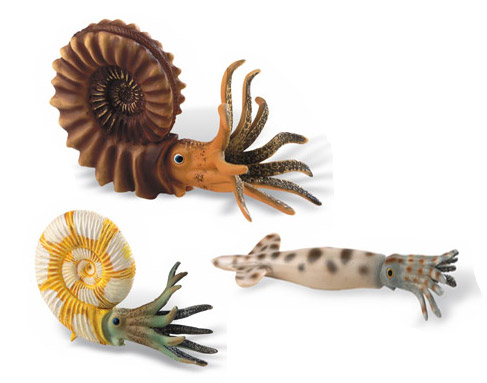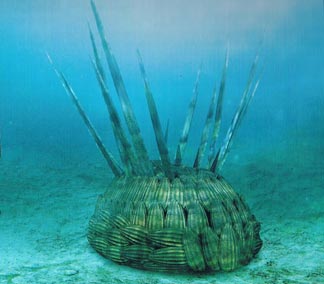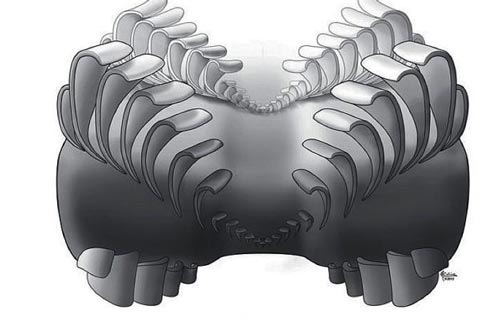Identifying the Origin of Mollusca by the Mouthparts
Burgess Shale Fossils Provide Evidence of the Origins of the Mollusca
The next time you come across a slug or a snail in your garden, or perhaps if you sit down to a plate of mussels in a white wine sauce with cream nod you head in approval towards one of the most successful animal phylum known on planet Earth – Mollusca. Now thanks to the use of a non-destructive research technique being applied by a Canadian researcher on fossil specimens from the famous Burgess Shale deposits, it seems that palaeontologists have finally begun to unravel the mystery as to how these animals first evolved.
Burgess Shale
The phylum known as Mollusca is one of the most diverse of all the animal phyla and thanks to most of its members having hard body parts and living in a marine environment, the Mollusca are perhaps the most abundant large invertebrates recorded as fossils. There are shelled and unshelled forms of mollusc. Although the six taxonomic classes that make up this phylum may seem very different, they all share the same basic body plan. There are the gastropods (slugs and snails), bivalves such as oysters, cockles and mussels and of course, the cephalopods, perhaps the most advanced of all the members of the Mollusca.
The cephalopods consist of a number of extant forms, such as squid, cuttlefish and octopi, plus some very important forms that are extinct but have proved so invaluable to palaeontologists as they develop biostratigraphical profiles of rock strata – long-dead groups such as the ammonites and the belemnites.
Ammonites and Belemnites- Extinct Members of the Phylum Mollusca
Picture credit: Everything Dinosaur
The picture (above) shows three invertebrate models in stock (whilst stocks last) at Everything Dinosaur.
To view models of iconic invertebrates from the fossil record: Replicas of Fossil Invertebrates.
Palaeontologists Studying Cambrian Strata
However, debate has gone on between palaeontologists studying the beautifully preserved Burgess Shale specimens (British Columbia, Canada), as to which of the many animal fossils dating from over 500 million years ago, represent the ancestors of the molluscs. Now thanks to the work of a University of Toronto PhD student, scientists are beginning to get a better understanding of how the molluscs evolved and which of the bizarre animal fossils from the Burgess Shale represent early forms of this important phylum.
Most molluscs possess a radula, rows of tiny, interlocking teeth that can rasp away drawing food into a primitive mouth which is then passed through a one-way digestive system. Only the filter feeding bivalves don’t have this “rasping tongue”. Using advanced electron microscopy to produce images that could then be modelled in three-dimensions, University of Toronto student Martin Smith was able to demonstrate that two bizarre types of Burgess Shale creature from the Middle Cambrian, Odontogriphus omalus and the heavily armoured Wiwaxia corrugata were forerunners of the Mollusca.
Odontogriphus omalus specimens are extremely rare in the Burgess Shale. This organism seems to have been a flat-bodied animal with mid-line symmetry (bilateral symmetry), a single muscular foot for locomotion and a toothed feeding structure with a simple stomach and intestine. Some fossils from the Burgess Shale strata indicate animals that grew to lengths in excess of ten centimetres.
Wiwaxia, on the other hand is a much more common member of the Burgess Shale assemblage. This might suggest that Wiwaxia spp. were more abundant in the warm, shallow tropical sea represented by this British Columbian strata, or it might simply reflect that greater preservation potential of Wiwaxia over Odontogriphus. Wiwaxia was certainly a striking animal. It had a body plan that was symmetrical around its mid-line, roughly elliptical in shape, toothed mouth-parts that were broadly conical and a primitive mouth and digestive tract. This thimble-sized organism probably pulled itself along using a muscular foot, the sides and the upper surface of this organism was covered by rows of overlapping protective plates called sclerites.
Shooting upwards from the dorsal area were two rows of parallel spikes. These spikes probably acted as a deterrent against attack from nektonic predators.
A Reconstruction of Wiwaxia corrugata
Picture credit: Everything Dinosaur
Previous studies had suggested that both Odontogriphus and Wiwaxia were basal forms of either the Mollusca or the Annelid worms, or perhaps they represented evolutionary dead-ends, types of creature that died out leaving no descendants.
This new research shows that the teeth of these animals sat on a grooved, primitive tongue and the shape, number and articulation of the individual teeth components and the way these structures grew puts these particular Burgess Shale members firmly into the mollusc camp. The ancestral molluscan radula is shorter and more squat than in similarly sized extant molluscs today. The mouthparts were made up of two or three rows of similarly, shaped teeth (shaped like miniature shoe horns); with a symmetrical central tooth and smaller denticles along the edges. The teeth would have moved round the end of a muscular tongue-like structure in a conveyor-belt-like fashion, scooping food and seabed detritus into the mouths of these primitive creatures.
They were not the sophisticated lettuce-munching radula of the common garden snail, but this new study by the Canadian PhD student does indicate that organisms like Odontogriphus and Wiwaxia are basal to the Mollusca.
Martin Smith, a student at the University of Torontos’s Dept. of Ecology and Evolutionary Biology and the author of the scientific paper published in the academic journal “Proceedings of the Royal Society B – Biology” utilised highly sophisticated electron microscopy to reveal new details of the mouthparts and structures in the fossil specimens. He examined over three hundred different Burgess Shale fossils and from the images produced by his study he was able to re-create three-dimensional models of feeding systems of these 5oo million year old invertebrates. Not only could the structure of these mouthparts be made out, the young scientist could also assess how these structures grew.
Commenting on his work, the student stated:
“I put the fossils in the microscope, and the mouth parts just leaped out. You could see details you’d never guess were there if you just had a normal microscope.”
Martin went onto add:
“The fossils are squashed completely flat, which makes them really hard to reconstruct in 3-D. “I surrounded myself with micrographs of the mouth parts and lumps of plasticine, and spent weeks trying to come up with a model that made sense of the fossils. When I set out, I just hoped to be a bit closer to knowing what these mysterious fossils were. Now, with this picture of the earliest radula, we are one step closer to understanding where the molluscs came from and how they became so successful today.”
An Illustration of the Short and Squat Radula-like Structure of Basal Molluscs
Picture credit: Marianne Collins
The teeth are arranged in rows and resemble miniature shoe horns. The Canadian research suggests that organisms like Wiwaxia and Odontogriphus used this structures to comb detritus or algae into their mouths. Over millions of years the radula of the molluscs has evolved and become a highly efficient feeding organ. Whether it is the rasp-like radula of a land snail that can tear up plants or the powerful mouthparts of a nektonic, active predator such as a giant squid the radula has had over 500 million years of evolution to refine it. Under a high powered electron microscope the formidable structure of the radula can be clearly made out.
The Fearsome Radula (High Magnifcation) of a Modern Mollusc
As can be seen in the above photograph, one of the reasons for the evolutionary success of the Molluscs might be their very specialised and highly refined, effective feeding structure – the radula. Some of the teeth in the image appear to be the same shape as those of a Great White shark (Carcharodon carcharias).





